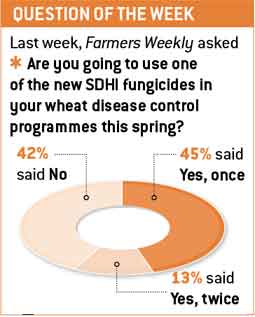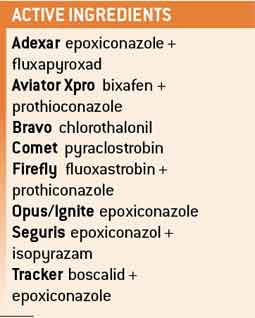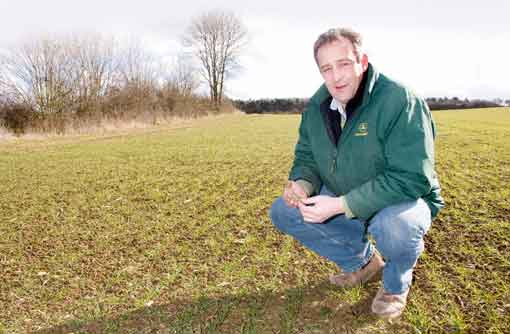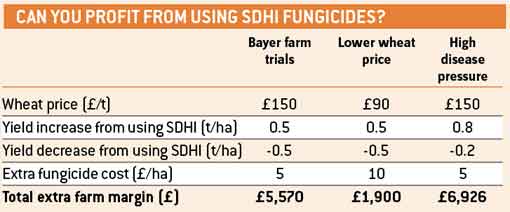SDHI fungicides: Should you use one?

Is it worth using an SDHI fungicide this spring in wheat disease control programmes? A quick look at the economics suggests it might be, although not all agronomists are convinced that they should be used in every situation.
With the arrival of BASF’s Adexar, there are now three mainline brands to choose from, Seguris from Syngenta and Bayer CropScience’s Aviator Xpro being the other two.
Each will be priced differently to the market, with Adexar, rate-for-rate, the most expensive, but all three can effectively be bought for around £34-36/ha. For Seguris and Aviator Xpro, that will buy you an 80% dose; for Adexar it is a 50% dose.
For most growers that will be at least £5/ha more than they used to spend on a flag leaf treatment, maybe double that if a triazole + chlorothalonil was the treatment of choice.
So is it worth splashing the cash on one of the new fungicides at flag leaf? Graham Redman, partner at business consultants, Andersons, believes it will be in most situations.
“From the evidence I’ve seen in HGCA and private company trials, even in a low disease pressure years with dry springs, the results from the past two seasons suggest SDHI treatments give higher yields.”
At current wheat prices of around £150/t for harvest movement, it doesn’t take much of a yield increase over the previous programme, for the fungicide to more than pay for itself, he says.
For example, at a premium of £8/ha, a yield response of just 53kg/ha is required to pay for the fungicide. “In HGCA trials last year using Adexar, even the trials with the lowest response gave at least 0.3t/ha.”
Even if the wheat price fell to £90/t, an £8/ha premium would only require an extra 0.09t/ha to pay. “I think in the majority of situations it will be worth a go.”
 Shropshire AICC agronomist Bryce Rham will be using Aviator Xpro but on a much wider scale after last harvest’s record yields. Although good seed-beds, strong rooting and well-timed rain underpinned that performance he’s convinced the widespread use of the product at T2 helped.
Shropshire AICC agronomist Bryce Rham will be using Aviator Xpro but on a much wider scale after last harvest’s record yields. Although good seed-beds, strong rooting and well-timed rain underpinned that performance he’s convinced the widespread use of the product at T2 helped.
“Bar a few acres of light land I used Aviator across the entire acreage. In a Bayer trial on one client’s farm, wheat treated with 1 litre/ha of Aviator outyielded all other treatments by 0.3t/ha.
“There is no doubt that more than paid for itself – it might be £8/ha more than the Firefly/Opus mix I’ve been using for the past three to four years but it produced £45/ha in extra yield.
“Currently septoria in the bottom of the crop is something to behold. On the well-bodied land I may well be tempted to put 1.25 litres/ha on and my gut feeling is that I’ll be using 1 litre/ha elsewhere pretty much across the board.”
Adexar looks “fantastic”, he says. “It’s awesome stuff. But at £43/ha for the recommended rate of 1.25 litres/ha I think it’s overpriced.”
And cutting the dose to half rate to bring the price more in line with Aviator Xpro doesn’t appeal. “When did we last put on a half dose of triazole at flag leaf? I’m not prepared to go down that route when I can use an alternative at 80% dose for about the same price.”
In Lincolnshire, AICC agronomist Bridget Carroll is taking a different view, already pencilling in Adexar on high-potential crops. “We didn’t see much response last year to new SDHIs because of low disease levels, but this year could be very different. Yellow rust and septoria are easy to find and I am very concerned about high levels of brown rust and stem-based diseases.
“Judging by how things look at the moment, if we don’t keep disease under control we could pay a very high price.”
While crops on drought-prone heath and sands are likely to continue receiving Ignite + chlorothalonil, she’ll use Adexar at 0.8 litres/ha on more fertile soils at flag leaf. “For 4-5t/acre crops Adexar really has to be the product of choice – it’s expensive but I think it’s worth it.”
After two dry, low-disease years across East Anglia, Cambridgeshire’S Strutt and Parker agronomist Jock Willmott is taking a more cautious approach to new SDHI fungicides.
 Only a limited amount of product might feature at T2, he says. “There a strong case for using new SDHIs at this timing provided there is enough disease pressure to generate a return. Last year this was confined to areas that had rainfall.
Only a limited amount of product might feature at T2, he says. “There a strong case for using new SDHIs at this timing provided there is enough disease pressure to generate a return. Last year this was confined to areas that had rainfall.
“But in drier conditions we saw disappointing and vary variable yield responses to fungicides. Although new SDHIs helped retain more green leaf I’m not sure that helped yield significantly. In low disease years or where crop prospects are limited there is little credible data to show they outperform a standard robust T2 mix.”
With buying groups and distributors offering product on sale or return, he will put some new product on farm. “We have product secured but we are not going to get carried away at this stage.”
Grower trials prove SDHI worth
Split-field commercial scale trials run by Bayer Crop Science carried out on 50 different farms across the country identified yield increases from the new generation of SDHI fungicides.
Based on its product Aviator Xpro, the trials were designed to test the product under commercial conditions, says Alison Daniels, Bayer Crop Science.
“We wanted to give it to farmers and not put them under any constraints other than just swap their current T2 with Aviator.”
Last season was unusually dry, she notes. “The average rainfall was extraordinarily low, so the expectation was it would be a poor season to see any responses from fungicides.
“However, it was also a year we could see what it could do without having a vast amount of disease about.”
Around 60% of growers saw a positive response, averaging 0.5t/ha increase, 25% were neutral and 15% saw a negative effect, Dr Daniels says.
At current wheat prices the increased costs from using an SDHI are easily overcome, she says. “The average extra margin over fungicide cost was around £60/ha.”
She puts the increased yield down to three key factors: ability to overcome drought stress, better utilisation of nitrogen, and better grain fill.
Case study: Richard Cobbald
Cambridgeshire grower Richard Cobbald was one of those who took part in the Bayer split-field comparison trials.

He compared Aviator Xpro directly with his normal regime using Comet, Tracker and Bravo. “We were going to try some on a field scale but with our combine mapping Bayer suggested we could do it on a split field, which gives a better comparison,” he says.
“The trial was first wheat after a double break on lightish land, sugar beet followed by peas, so we would usually expect a reasonable yield.
‘Unfortunately the ground cooked out but we still did see a 0.25-0.5t/ha uplift where the Aviator was used, against a Comet + Tracker + Bravo approach, although we only ended up with a 7.5t/ha average over the field,” he says.
“The only thing that I can say caused the yield increase would have been the extra greening effect the SDHI gave, which allowed a little bit of the late nitrogen in, when it finally rained.”
This year, Mr Cobbald intends to base his flag leaf fungicide on an SDHI, which he expects to be common practice among growers.
[Box & Table] How much could SDHI fungicides add to the bottom line?
The following table is based on the Bayer CropScience split-field trials where 56% of fields showed a positive response, 29% were neutral and 15% negative. Using a typical 400ha arable farm, growing 50% wheat (200ha), the farm is split into the same proportions showing a positive, neutral or negative yield response.
In the first scenario (Bayer farm trials), the yield response figures are based on what growers saw in those trials last season. The second scenario is a more downbeat situation of lower grain prices and a higher differential in fungicide costs, while the third study looks at where disease pressure is higher making the potential responses from SDHIs higher and lower negative yield responses.
In all three cases the farm makes a greater return by using SDHI fungicides across the area at T2, assuming the same proportions of positive, neutral and negative yield responses as in the Bayer farm trials last season.


